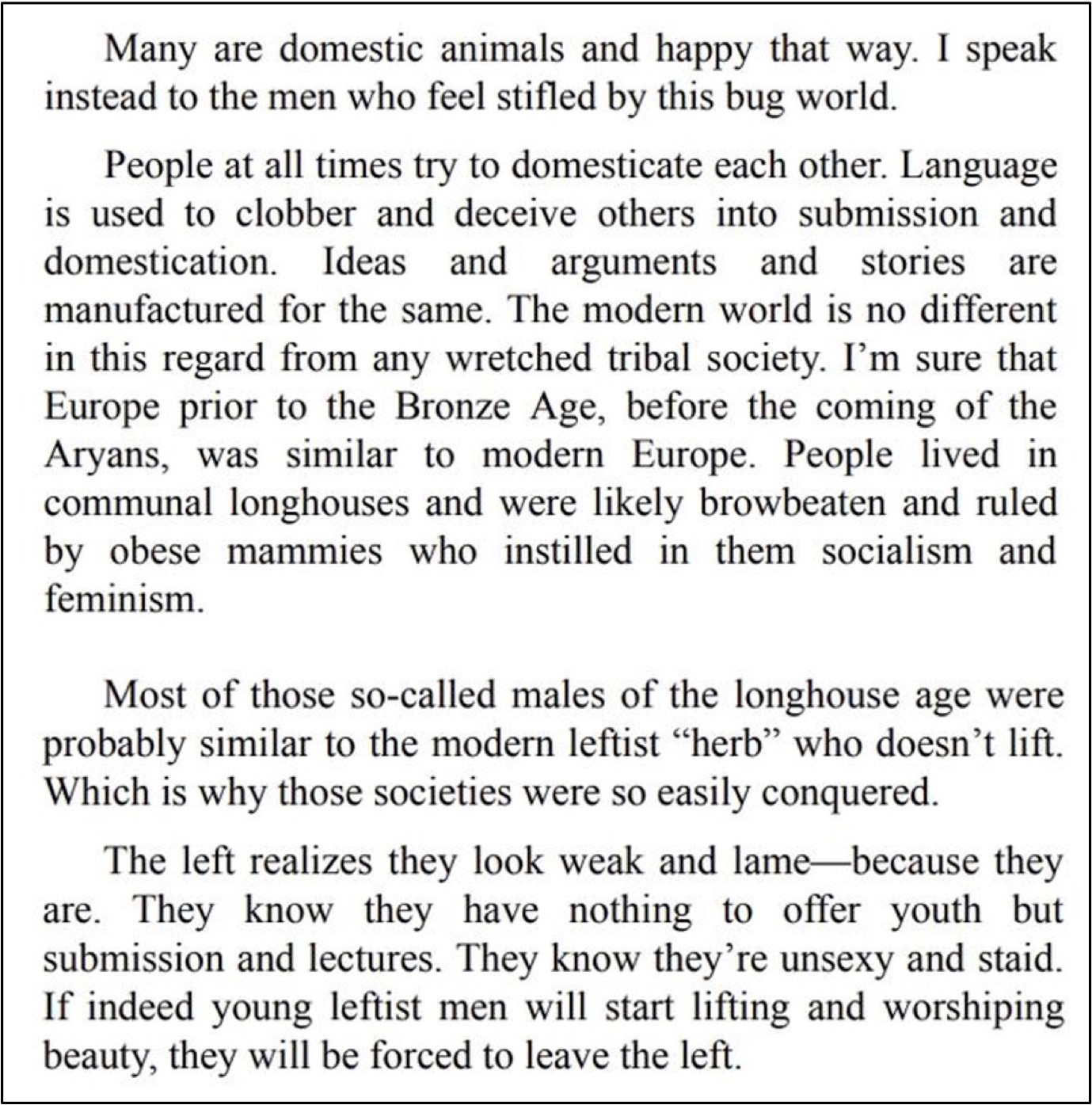After the ‘muzzle velocity’ onslaught of the first four weeks of the Trump administration it might seem quaint to be talking about a ‘vibe shift.’ ‘Vibe’ is a rather diaphanous term, and trying to understand current events through vibes is perhaps like looking too-intently at the velvet wrapped around an iron fist. The vibe in question is not, however, marked by a fondness for gauzy-like woo. It is hard, posturing, and distinctly masculine-coded. The vibe has come, like a conquering hero, to set the world to rights, a world gone wrong, we are led to believe, because it allowed itself to be fatally feminised.
The professional trend spotter Sean Monahan, who first coined the term ‘vibe shift’ back in June 2021, has named the feel of this new epoch ‘Pilled/Scene,’ replacing the age of ‘Hyperbeast/Woke.’ Over recent years, the Matrix-inspired metaphor of ‘red-pilling’ has escaped its original home in the manosphere, where it fuelled the rage of incels and MRAs by revealing the ‘reality’ that the world is run by feckless sluts who spend their time riding the alpha ‘cock-carousel,’ while exploiting beta ‘cuck’ males for financial and emotional support. It has since embedded itself in many internet subcultures and strands of right-wing thought, from QAnon and Covid conspiracy theory—where it reveals the reality of the evil machinations of the ‘Deep State’—to the neoreactionary writings of Curtis Yarvin, whose critique of the liberal consensus-machine he calls ‘The Cathedral’ is beloved by Peter Thiel and the Dark MAGA broligarchs. What links the new vibers is that they imagine themselves upstart rebels against entrenched establishment illusions, wiping away the corrupt ‘ancien regime’ as Thiel put it in a bizarre op-ed days before Trump’s inauguration. And they somehow persist in imagining this even as Trump assembles an administration with a total net worth of $430 billion, or as the richest man in the world seizes the levers of government and slashes the shit out of federal spending, and then goofs around with his son in the centre of the Oval Office. And this is one of the tragedies ushered in by enforced woke overreach: it has given old skool patriarchy, and an undisguised clamouring for dominance and riches, the opportunity to style itself as countercultural and, of all things, edgy.
The new vibers can’t quite get their story straight about exactly what was so wrong with the ‘ancien regime.’ It might be the Deep State, or ‘globalist elites,’ or ‘the Far Left,’ or the World Economic Forum, or indeed, for the likes of Yarvin, liberal democracy itself. One thing they can all agree on is that a universal index of the problem is the ‘woke mind virus,’ or Diversity, Equity, and Inclusion-programmes which, according to information leaked from the National Science Foundation, now encompass any research to do with ‘equality,’ ‘ethnicity,’ ‘disability,’ or, indeed, ‘women.’ By this stage of the game, a lot of words have been spilled on exactly ‘what woke is,’ and ‘what was wrong with woke.’ This last question has preoccupied leftists, radical and materialist feminists [1], disaffected liberals, and assorted right-wing culture warriors over recent years, and unpicking these various accounts, and what they tell us about where we are and whether it’s remotely the right place, is one thing I want to do with this project. Here, I want to focus on how the ‘Daddy’s Home’ tenor of the current shift relates to one particular narrative the new vibe warriors have been telling about what was wrong with woke, and examine the work that has gone into selling the story that, in the words of James Lindsay “Woke is a woman.”
A key concept here is ‘The Longhouse,’ a new and improved version of MRA-lore, in which the women running the world are no longer feckless sluts but HR managers, academics and administrators. According to an explainer at First Things, this state of affairs has led to “the remarkable overcorrection of the last two generations toward social norms centering feminine needs and feminine methods for controlling, directing, and modeling behavior.” The phenomenon of wokeism is here read as a product of the overrepresentation of women in certain areas of public life, and a direct emanation of essential feminine nature [2]. This essential nature has two fundamental, yet somewhat contradictory, aspects: the tendency of women to be overly-agreeable and empathetic, and the tendency of women to engage in underhand competition by trying to trash other people’s reputations (we might call this the ‘Women-Be-Kind vs. Women-Be-Bitches Paradox’).
The ‘Women-Be-Bitches’ dimension of female nature is linked straightforwardly to the ‘wokescolding’ aspect of social justice activism, because evidently, being a scold is something women are known for. The slightly more sophisticated version of this argument often relies on a 2013 evopsych paper by Joyce F Benenson, which analyses female intrasexual competition, arguing that “[f]rom early childhood onwards, girls compete using strategies that minimize the risk of retaliation and reduce the strength of other girls” which include “avoiding direct interference with another girl's goals, disguising competition…enforcing equality within the female community and socially excluding other girls.” From this then comes the thought that female aggression, or ‘toxic femininity,’ primarily exhibits itself by inflicting reputational damage on others, and is hence a key driver of ‘cancel culture.’ Versions of this argument have been advanced by Jordan Peterson, Louise Perry, and Tara Henley over at ‘Fairer Disputations,’ the self-styled centre for ‘Sex Realist Feminism for the Twentieth Century.’ Henley’s recitation of Perry’s analysis, given on a podcast with Meghan Daum in 2022, goes as follows:
Look at social media if you want to see feminine aggression at play…On Twitter, everyone fights like a girl…You’ve got to use your feminine tools, like reputational damage, and turning people against outcasts from the in-group…Cancel culture is girls’ school culture.
This is not an entirely baseless thought. I have sometimes privately joked that we ended up with cancel culture because it was bred on Tumblr in the mid to late noughties, and Tumblr was a space dominated by teenage girls who ended up producing a political culture by rehearsing the tropes of academic identity politics as if they were starring in Heathers (apologies to everyone below Gen X who has no idea what I’m on about). However, it’s worth noting here that the adjective ‘Machiavellian’ didn’t originate in descriptions of the behaviour of bitchy schoolgirls, and the idea that men just straightforwardly exercise political power, while only women are manipulative and underhand, is absurd. Secondly, it is reductive in the extreme to suggest that the tribal in-group/out-group mechanisms that characterise identitarian politics on both the left and right are a singular emanation of feminine cliquiness, as if tribal aggression, and its associated black-and-white thinking, was solely a female trait. (Indeed, by a sexual difference analysis oppositional and identitarian thinking is the hallmark of patriarchal logic.) Any explanation which seeks to explain woke cancel culture by positing it is a direct expression of the female soul, and ignores the material, historical, political and technological conditions of its emergence, is going to be far from complete. As I hope to discuss with Dr Carina Westling in a forthcoming podcast, the architecture of social media platforms, and their tendency to promote identitarian opposition, is far more significant in generating the intolerance to dissent, and political polarisation, we see all around us today.
The claim that cancel culture is an essential expression of ‘Women-Be-Bitches’ also sits in uncomfortable tension with various arguments that seek to explain wokeism by reference to women’s excessive amiability or empathy [3]. As Amy Wax tells it to Louise Perry in their discussion on ‘The Feminisation of Academia,’ the issue is women’s “warm bath attitude” which ushers in “the elevation of the values of the nursery and kindergarten over the traditional established…values of the academy” like “truth seeking…empiricism…sportsman-like rigorous, vigorous, disagreement and argumentation and reason.” This is really packing a punch of gendered tropes, laying the blame for the bullshittery of a lot of woke scholarship on the immemorial conflict between hard masculine reason and soft feminine emotion (this coding of rigorous masculine delineation vs. feminine fuzziness goes back at least to the Pythagorean Table of Opposites). It suggests that the values of care, or mutual respect, are antithetical to the possibility of empirical truth-seeking, which essentially depends on a type of vigorous competition allegedly incompatible with empathy for others. This paints a picture of a world where women undertake intellectual activity as if organising an egg-and-spoon race, the point of which is to pat every little Jonnie and Jane on the head for taking part. Nearly a quarter millennia after Wollstonecraft vindicated the rights of women by arguing we are as capable of reason as men, it seems many people—women included—still consider such claims outlandish.
Along with this comes, of course, the characterisation of woke bullshittery as a product of feminine feeling over masculine fact. Having wasted a good deal of time over recent years arguing with right identitarians, I am pretty confident they are as impervious to inconvenient facts as their left identitarian counterparts. But no one should let annoying empirical phenomena get in the way of a good, gendered yarn. A central thought here is taken from Haidt and Lukianoff’s 2018 book, The Coddling of the American Mind, in which Wax’s account of ‘the values of the nursery and kindergarten’ is rendered as the notion of ‘Safetyism,’ and used to explain the prioritisation of harm-avoidance over truth-seeking and robust intellectual exchange. It certainly seems to be the case that the mental health of the younger generations is markedly suffering, and they have been encouraged to strategically weaponize this in evidently unhelpful ways to control public discourse over recent years. I am far less convinced that the reason for this is a feminine culture of coddling, rather than say, the fact that the world is objectively going to hell in a handcart. Having sucked up the future in 2008, the architects of our iniquitous system of extraction have since decided to do Supermarket Sweep on whatever they can get their hands on before letting everything burn to the ground and then spiriting themselves off to carefully prepared bunkers in Hawaii or New Zealand. I am not remotely surprised the kids are not alright.
Indeed, while the new vibe shifters are fond of pointing the finger at ‘globalist elites’ and claiming, as Aayan Hirsi Ali did in her recent ‘A New Year Message,’ that they are advocating for “[p]eople who have been betrayed or forgotten” by the “discursive strictures of woke-inflected neoliberal regimes,” there is very little recourse to explaining wokeism in terms of the material conditions created by ‘neoliberal regimes,’ and a great deal of emphasis on culture-war explanations that operate using symbolic tropes, many of which cluster around conventional notions of gender. Another iteration of this is given by Heather Mac Donald in her essay ‘In Loco Masculi,’ which explains the woke obsession with trauma-triggers and harm-avoidance in terms of female-typical neuroticism. She writes:
Female dominance of the campus population is intimately tied to the rhetoric of unsafety and victimhood. Females on average score higher than males on the personality trait of neuroticism, defined as anxiety, emotional volatility, and susceptibility to depression…When students claim to be felled by ideas that they disagree with, the feminized bureaucracy does not tell them to grow up and get a grip. It validates their self-pity.
Interestingly, this revives an argument used by third-wave feminists to gut academic feminism of its analysis of sex-based oppression and opposition to male violence, claiming that such feminism was obsessed with a disempowering image of female ‘victimhood’ (for those interested, I discuss this construction of ‘victim feminism’ in the ‘Methodological Considerations’ section of my PhD here). This thought has become a mainstay of right-wing culture-war narratives about ‘wokedom,’ displayed famously, for example, in the title of ‘The Grievance Studies Affair.’ Once again, the precise source of the alleged victim-complex moves around a fair bit [4]. It might be, according to James Lindsay, “rooted in that postmodern brand of ‘theory’” that “we have come to call…‘grievance studies’… because of their common goal of problematizing aspects of culture…to attempt diagnoses of power imbalances and oppression rooted in identity.” It might, according to James Lindsay somewhile later, be more fundamentally based in the model of oppressor/oppressed dynamics which, he argues, characterises all species that descend from the genus ‘Marxism,’ and is somehow a form of gnostic heresy. (No. Me neither). Or it might, as Mac Donald, and other theorists of deleterious femininization would have it, simply be a straightforward emanation of the fundamental features of the female soul. (How the female soul is responsible for Marx’s concern with capitalist exploitation is a story yet to be told).
There is a good deal more gender-coding at work in the proposition that ‘Woke is a woman.’ One that particularly interests me, and I will probably devote a forthcoming post to unpacking, is the ontological implications of the opposition between masculine hardness and feminine softness, and how this relates to current conflicts between right and left identitarians over norms, borders, and boundaries. There is a substantial dash of old-fashioned Freudianism at work in the thought that the parlous state of our civilisation is down to the erosion of boundaries by the forces of feminine-coded chaos. Here the account of wokeism’s ‘suicidal empathy’ bleeds into concerns about open borders [5], the crumbling order of the patriarchal family and the tumbling (white) birth rate becomes associated with visions of uncontrolled female flesh, and there is a generalised sentiment that we are in this predicament because our men got softened up by the domesticating comforts and stifling feminine strictures of liberal modernity.
At this point we return to an invocation of life in the longhouse by the alt-right internet personality Bronze Age Pervert, a vision in which, as Mary Harrington writes, “Western men have grown contemptibly soft, relinquishing a life of confident vitality in favour of a weak and resentful mass culture” and “masculine excellence is…nipped in the bud…by a stifling, safety-obsessed egalitarianism” [6]. As Jonathan Keeperman, author of the First Things explainer, tells it, the menacing ‘Den Mother’ who rules over the longhouse “censures the drive to assert oneself on the world, to strike out for conquest and expansion. Male competition and the hierarchies that drive it are unwelcome.” This longing for heroic adventure chimes with Santiago Pliego’s ‘Vibe Shift,’ cited by Niall Ferguson in ‘The Vibe Shift Goes Global.’ Pliego, whose Twitter account features an improbable number of cowboys, wrote in early 2024 that the ‘vibe shift’ is “the rejection of reality denial and…embracing that men and women are unique and different,” “laughing at those trying to demonize men and cheerfully proclaiming ‘Dudes rock,’” and calls for “a time for real courage…we’ve indulged in cowardice for too long.”
I’m all for courage, and for a world where every individual has the chance to forge a path that feels meaningful and full of purpose. It’s the one point on which I agree wholeheartedly with Jordan Peterson, although in his case, and I suspect Pliego’s, I immediately depart from the baseline assumption that such meaning-making is the sole province of the masculine, and that hero’s journeys were never meant for heroines. There is a great deal we can say about why a dematerialised, micromanaged, output-oriented, technocratic culture has been stifling the human sense of adventure and unalienated purpose, but I’m absolutely sure it’s not because there’s a lot of women working in HR. With all its claims to reject ‘reality denial,’ and appeals to scientific grounding in evopych, the gendered coding of the woke-as-woman discourse is so transparently reductive, un-elucidatory, and patriarchy-pleasing, it appears as much an ideological artefact as the paradigm it claims to overthrow.
Beneath the effort to project woke as a woman, and the chorus protesting the castrating mother’s stifling of authentic male power, there are also some dark imaginings clearly visible. Indeed, the tenor of ‘Daddy’s Home’ was perhaps most honestly expressed by Tucker Carlson’s inordinately creepy speech at a rally in Georgia in October 2024. Here, Carlson figured America’s old order as an insolent adolescent girl who needs to be set on the straight and narrow with a good hard spanking delivered by Daddy Trump. This speech, which raised more than a few eyebrows during the campaign trail, tells us something central about the spirit of the new vibe, and explains a great deal of the ‘muzzle velocity’ or ‘move fast and break things’ ethos of the new administration. While it was once useful for the new vibe warriors to pose as advocates of robust rational debate when presenting themselves as the countercultural alternative to repressive woke piety, they have exhibited precious little interest in ‘talking it out’ with their political opponents or abiding by the principles of liberal democratic engagement in almost any way at all. All the culture war arguments about what was wrong with woke have now served their purpose. The plan was always to engineer the moment when daddy came home, and then slap it into submission.
[1] See for example my section on ‘Woke Criticism’ in The Annals of the TERF-Wars and Other Writing.
[2] Just to be clear at this point, I am not a complete blank slatist, and I do not believe blank slatism is a necessary condition of a coherent feminist critique of gender, see ‘Both/And: Gender.’ However, even if we accept that there are some very general personality distributions by sex at the population level, which function in a very overlapping bell-curvy kind of way, this is a still a good distance from making grand claims that you can explain complex social and historical phenomena as a direct emanation of sex-based essence, and this is before we even get to the fact that these appeals to these ‘sex based personality traits’ slide very easily into sexist tropes.
[3] There is an interesting moment in the podcast between Perry and Wax where Perry is wanting to push the ‘bitches’-take and Wax wanting to push the ‘irrational fuzzy warm bath’-take.
[4] It’s also worth noting here that the entire ‘red-pilled’ narrative engine is fuelled by grievance. For reasons yet to be fully disclosed, when lefties and women and racialised minorities complain about being oppressed it is a disgusting manipulative display of ressentiment and weakness. When right-wingers spend 40 years complaining about how oppressed they are by liberals stopping them being sexist and racist and carefully laying down a plan to wrest back control of society, this is just the proper assertion of masculine fortitude.
[5] At this point in the argument of course, the problem with Western culture shifts from its own pussification and becomes instead the influx of patriarchal primitives who don’t treat women anywhere near as well as we do. Apparently the formula is ‘Bronze Age Pervert good, Medieval Islamic Barbarian bad.’
[6] It’s notable here that for the last-however-many-centuries, while men have thought themselves comfortably on top of the sex-based hierarchy, they have reliably asserted ‘the myth of forever patriarchy’ and rubbished feminist efforts the think through other forms of social organisation. Suddenly, however, with women gaining some social power, it is decided there was indeed a world before patriarchy, and it was emphatically terrible. For discussion of ‘the myth of forever patriarchy’ see Esmée Streachailt’s discussion of the work of Marija Gimbutas, ‘For 40,000 Years Women Lived in a World That Did Not Hate Us – Part 1,’ The Radical Notion Issue Eleven, Spring/Summer 2024, and my conversation with Max Dashu from Issue Six.










Since Eve onward, it’s all about blaming the b*tches for men’s failings.
Don’t want to have to think for yourself? Eve’s fault.
Can’t keep it in your pants? Sluts’ fault.
Can’t stop yourself from abusing women (& children)? The fault of meddling women who won’t just let you have your way.
We men fucking suck.
Sorry, trying my best here to make a dent, but JFC most are thick as two short planks.
I didn’t vote for Trump or the idiot (and please why can’t people admit that she is an idiot?), but there are several things that he has done in his first month that I agree with.
There are three executive orders (EO’s) that Trump has signed that are worthy of support by everyone across the moderate political spectrum
The first of these EO’s recognizes that open borders are politically unacceptable and that the age of mass migration is over. Importing millions of people who will work for next to nothing just to be here destroys the wages of working class Americans and drives up housing costs when we can't house our own citizens. People cannot overpopulate their home country and just expect to move to greener pastures. There are no more green pastures. They need to voluntarily reduce their own country's population to an environmentally sustainable level, stay home and work there to improve their living conditions.
His second important EO addresses the insanity of gender identity which denies the reality of human sexuality and results in men invading women’s sports, restrooms, locker rooms and prisons. Women need and are entitled to privacy from men. Even more diabolical is the mutilation of innocent children (many who would grow up gay) in pursuit of the impossible because you can’t change your birth sex.
Finally his EO that corrects the craziness of DEI which discriminates against whites, Asians and men in attempting to cure past discrimination against others is absolutely the correct approach. Who could believe that creating a new privileged class and a new discriminated against class would provide a solution to the problem? Not to mention that it’s clearly unconstitutional.
It would well serve both Democrats and independents to get behind these changes even as they choose to vigorously oppose other aspects of his agenda.